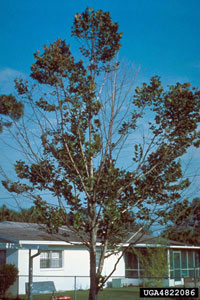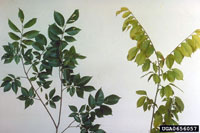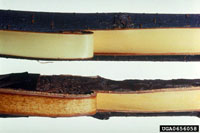Extension > Garden > Diagnose a problem > What's wrong with my plant? > Deciduous Trees > Elm > Clumps of stems/sprouts on trunk or branches
Elm > Trunk/Branches > Clumps of stems on trunk or branches
1 of 2
Botryodiplodia canker
Botryodiplodia ulmicola
- Clumps of adventitious sprouts or shoots develop below cankers on large branches
- Leaves growing beyond the canker turn yellow and wilt (Siberian elm) or fall off (American elm)
- Reddish brown to black water soaked cankers form on branches 4 inches in diameter or smaller
- Sap wood underneath the canker is reddish brown
- Tiny raised pimple like fungal structures form on branches killed by the canker, causing bark to look rough
- Damage is most severe on trees stressed by other factors
- More information on canker
2 of 2
Elm yellows or Elm phloem necrosis
Elm yellows group or clover proliferation group
- Witches’ broom or dense leaf clusters at branch ends, common on red elms
- Leaves in the entire canopy turn yellow, droop and fall off, often all in a few weeks time
- Occasionally, leaves can shrivel, turn brown and remain attached to branches for several weeks
- When bark is peeled back, the inner bark is yellow brown and smells of wintergreen (American elm) or maple syrup (red elm)
- Damage appears mid to late summer; infected trees die within a year or two
- All Minnesota elm species are susceptible
- More information on Elm yellows








